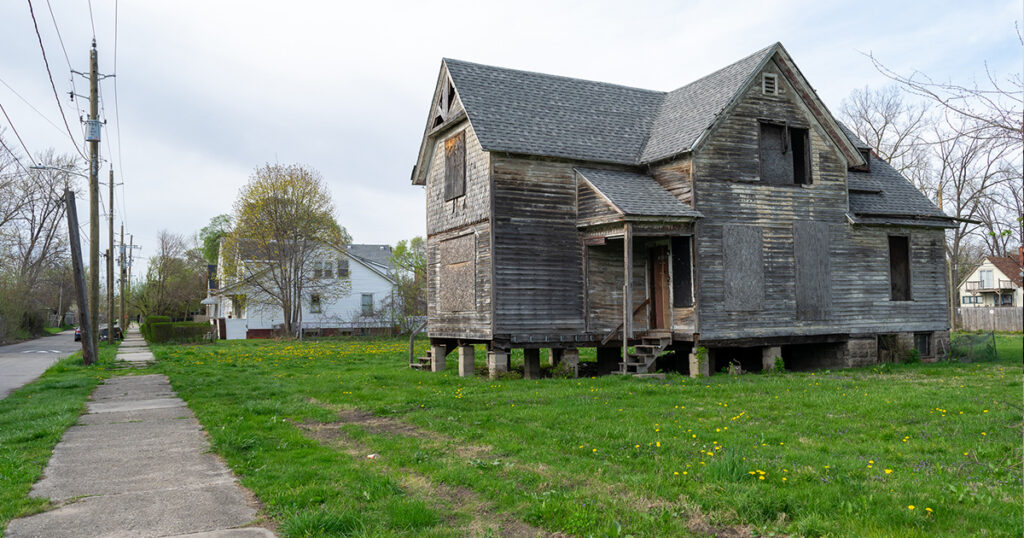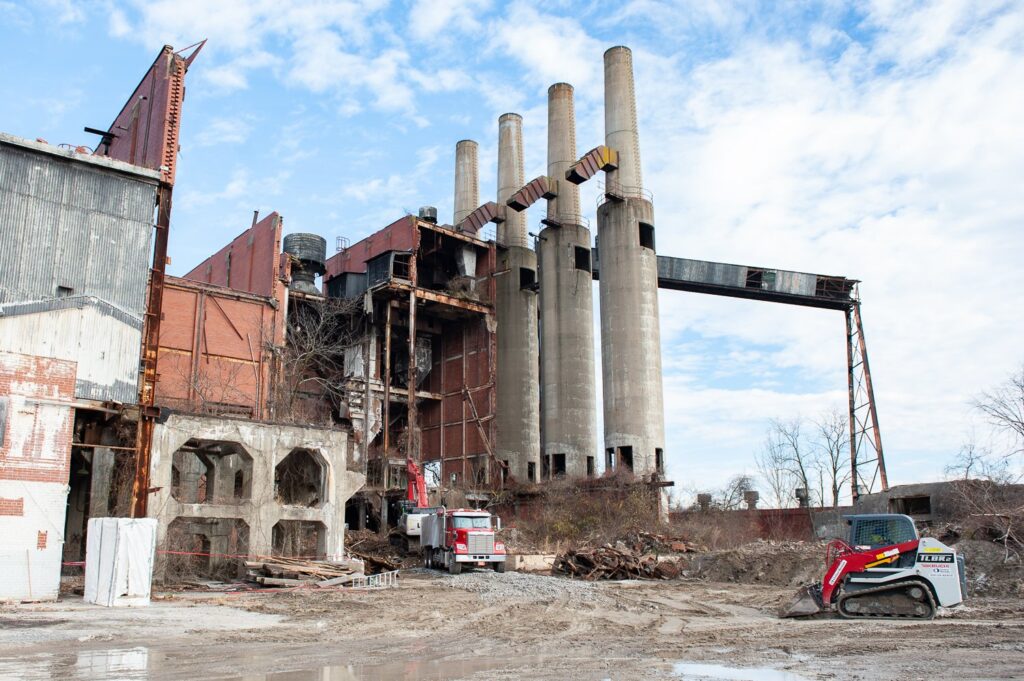Topic(s): Brownfields, Land Banks
What is a Brownfield?
April 21, 2025

Vacant, abandoned, and deteriorated properties threaten the health and wellbeing of neighbors and neighborhoods. However, some properties pose a greater threat than others. One high-risk property type is brownfields.
What is a brownfield property?
Brownfield properties, often referred to as “brownfields,” are properties where the presence or potential presence of hazardous substance, pollutant, or contaminant makes redevelopment challenging and costly.
Not all brownfields are contaminated, and not all contaminated sites are brownfields. For example, an active gas station with a leaky underground tank is causing pollution but would not be considered a brownfield because it is still an operating business.
On the other hand, a neglected and poorly maintained former auto repair facility might have the perception of being contaminated and thus meets the definition of a brownfield—even if sampling data show it’s safe to redevelop.
Other examples of brownfield properties include:
- Shuttered coal mines and power plants
- Closed factories and industrial facilities
- Bus facilities and other land previously used for air, ground, or rail transport
- Abandoned gas stations and other commercial businesses that used hazardous substances like dry cleaners
- Vacant lots with chronic illegal dumping
- Residential or commercial buildings built before 1989 (due to the presence of asbestos or lead paint)
The Environmental Protection Agency estimates there are more than 450,000 brownfields in the United States.

Why are brownfield properties harmful?
Brownfield properties are challenging to redevelop because, when active, they might have been home to businesses and industries that used chemicals harmful to human health and the environment. Over time, arsenic, asbestos, lead, petroleum and hydrocarbons (PAHs), volatile organic compounds (VOCs), and other contaminants can infiltrate soil, groundwater, airborne particles, and structures due to spillage, improper storage, or container and property deterioration.
These pollutants can endanger community health if people are exposed to the contaminant particulates or vapors. Recent research found that abandoned oil and gas wells in Pennsylvania are still releasing cancer-causing gases. Black residents in the Rust Belt (the region most associated with America’s legacy manufacturing hubs) are “33% more likely to receive lung cancer diagnoses—the cancer most associated with air pollution exposure—than Black people living in the country’s 38 other states.”
Vacant, abandoned, and deteriorated properties—including brownfield properties—are disproportionately located in low-income communities and communities of color. This is in part because of the economics underlying systemic vacancy: Land in a community that has experienced decades of poverty, economic decline, and population loss will not appear economically viable for most investors.
EPA data shows that communities which received EPA brownfield funding have a higher percentage of vacant properties, and that people of color and families living below poverty level within those communities are more likely to live near brownfields.

How can we address brownfield properties?
Despite many challenges, the movement to reclaim brownfield properties is gaining momentum.
The best route a community can take to address their brownfields is to remove risk related to environmental cleanup liability. This includes performing due diligence and site investigations (i.e., drilling, collecting samples, doing laboratory analysis) to eliminate uncertainties about the presence and type of contamination, if any. The EPA’s Technical Assistance for Brownfield Communities Program is an excellent resource for communities starting to address brownfield challenges. Once the community knows the extent of contamination, if any, they can plan and implement cleanup and redevelopment, priming the site for future reuse. Another resource is the EPA’s Land Revitalization Technical Assistance support, which helps communities with the early stage planning work around brownfields.
Brownfield redevelopment reclaims the potential of valuable, underutilized land to improve a community’s environmental, social, and economic conditions. You can find creative examples of brownfield redevelopment across the country.
- In West Virginia, former power plants, factories, and mines are centrally located on flat ground, a rare commodity in the mountainous state. Local entities like the West Virginia Land Stewardship Corporation are working to transform them into community assets with the help of EPA funding.
- State-level brownfield financing legislation in Michigan has enabled developers to access a patchwork of funds to clean up and convert former auto plants and other brownfield sites into new residential and commercial space.
- The City of Williamsport, Pennsylvania is using American Rescue Plan Act (ARPA) funds to turn former landfill and manufacturing land into a baseball complex for the community.
Public and private entities have many sources of capital to access when pursuing brownfield redevelopment, including tax credits, tax increment financing, federal and/or state brownfield grants, and support from other federal agencies like HUD, USDA, USDOT, and more. A key element of success in brownfield projects is creative public financing and cross-sector collaboration.
Another promising tool for dealing with brownfield properties is land banks—public entities with unique powers to return problem properties back to productive use in accordance with community goals. A land bank’s primary purpose is to acquire these properties (sometimes called “blighted” properties) and temporarily steward them until they can be transferred to new, responsible owners. In 2023, Community Progress was awarded a nearly $500,000 grant from the EPA to advance cleanup and community-driven reuse of brownfield sites through land bank partnerships and support the implementation of land bank brownfield work.
After interviewing land banks across the country, we developed case studies of brownfield redevelopment from three land banks that helped transform industrial and polluted properties into opportunities for economic growth for their communities; a step-by-step guide for brownfield redevelopment; and practical considerations for redeveloping brownfields.

Examples of brownfields redevelopment facilitated by land banks
- Michigan’s Genesee County Land Bank used state and federal funds to demolish and remediate a former oil change business at a key entrance to downtown. Local partners used the property, and several other nearby parcels acquired by the land bank, to build the Center for Children’s Integrated Services, which provides comprehensive physical and mental health treatment to Genesee County children.
- The Suffolk County Land Bank on Long Island, New York was created in 2013 with a primary focus on tackling brownfields. They have acquired 39 brownfield properties in 10 years, completed nearly 100 environmental assessments, and helped return nearly $8 million in assessed value to the tax rolls with reuses that support neighborhood vitality and health.
- Ohio has one of the most well-established and expansive land bank networks (70 land banks as of January 2024). The state views land banks as a key community development partner and allocated $350 million to a brownfield remediation program in 2023, relying almost exclusively on county land banks as primary recipients to carry out the program’s goals.
- The West Virginia Land Stewardship Corporation (WVLSC)—a statewide entity that supports the 12 land banks in West Virginia—acquired a 2.1-acre former coal-fired power and water filtration plant in the Morgantown Industrial Park. “The Smokestacks” site was donated for cleanup in exchange for a property management fee paid by the industrial park owner. An EPA Brownfields Assessment Grant funded successful Phase I and II environmental assessments of the site and WVLSC and partners used a Brownfields Cleanup Grant for site remediation to transform the property into a loading and storage facility that supports the entire industrial park.
Brownfield properties represent an opportunity for communities across the country to reuse existing infrastructure to boost local economic development and community wellbeing. With the right tools, resources, and expertise, communities can reclaim these blighted properties and pave the way for a sustainable, vibrant, healthy future.
If you’re struggling with vacant, abandoned, and deteriorated properties in your community, check out our free online resources, webinars, and publications. The Center for Community Progress also provides customized, expert guidance to state and local governments to assess the state of vacancy in your community and recommend policy and practice solutions for equitable neighborhood revitalization. Contact us at [email protected] to learn more!
This post was made possible via grant funding from the US Environmental Protection Agency and with generous support from the Robert Wood Johnson Foundation and the JPB Foundation.
Subscribe to join 14,000 community development leaders getting the latest resources from top experts on vacant property revitalization.
